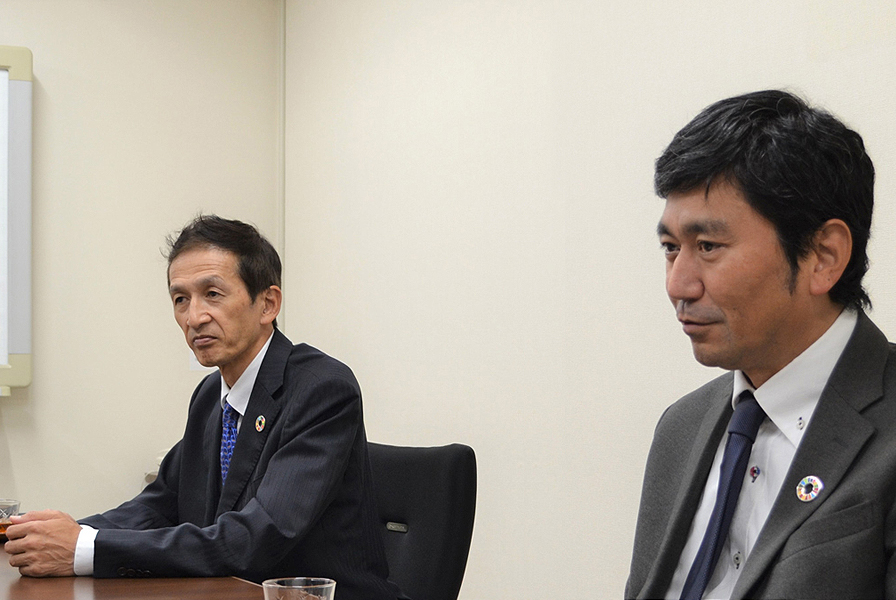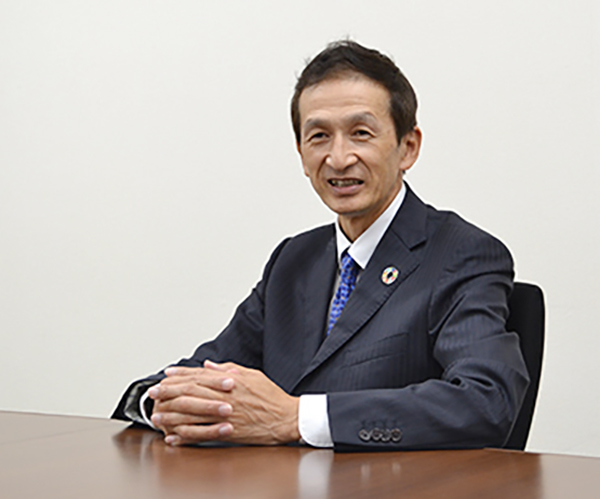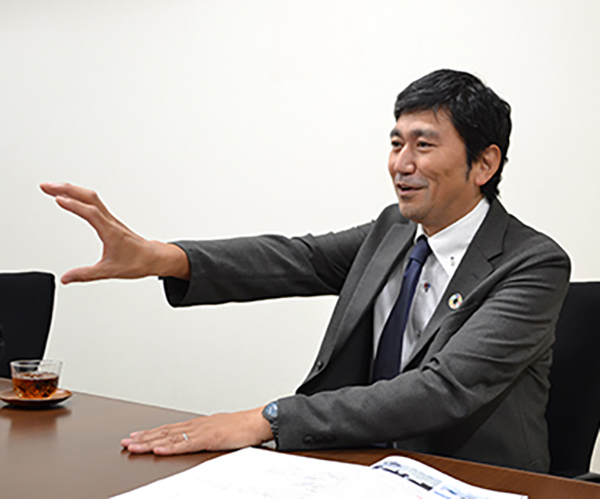Opening up new markets and businesses with network technologies cultivated since OKI's establishment
SUMMARY
OKI's Innovation Promotion Division seeks co-creation partners with whom innovations can be realized together in an aim to create new business opportunities. As a good innovation partner, "What can OKI do? What will OKI do?" - The key person behind each business will introduce the values and possibilities that OKI offers.
In this ninth round of talks, we look into OKI's business strategies based on network technologies that have been continuously cultivated since its establishment as Japan's first communication equipment manufacturer. Joining us for the talk are two individuals from the ICT Business Group. One is Ryo Sasaki, head of the Network Systems Division. The other is Shinichiro Nishida, chief specialist of the IoT Platform Division.

Latest articles
Contributing to expand domestic and international IoT needs beginning with 5G for telecommunications carriers and 920MHz band wireless for enterprises
Provide us with overviews of your divisions
SasakiThe Network Systems Division offers various network equipment and broadband service systems that target telecommunication carriers, service providers and major corporate customers. In addition, we are concentrating on the network edge, and have delivered more than 10 million units, including home gateways and ONUs (optical network units) for communication carriers.

Head of Network Systems Division
ICT Business Group
Oki Electric Industry Co., Ltd.
NishidaAt the IoT Platform Division, our primary mission is to supply various products for corporate customers including traditional PBXs and business phones, contact center systems, our "EXaaS" managed cloud service, the various sensors, data processing and analysis systems for IoT, and 920 MHz band(*1) multihop wireless systems. System proposals and provisions to customers are handled by the solutions divisions set up within the ICT Business Group for each market area and the sales partners that OKI has had relationship with for many years. The IoT Platform Division provides technical support during proposals and system constructions.
What businesses is the Network Systems Division currently focused on?
SasakiOne major topic we are focused on is the contribution to the infrastructure construction of the 5G(*2) network, which is due to be commercialized after 2019 for the next generation mobile services. We recognize that the 5G infrastructure will result from the migration of existing networks, so we are certain that our knowledge and expertise accumulated through our involvement with the telecom network market will be become useful.
In parallel, we are promoting business expansion with "5GxIoT." We are specifically putting our effort into "video IoT" and "audio IoT" applications.
For the former, we have already released a video IoT system called "AISION," which is equipped with video compression and image sensing, and we intend to include additional values such as AI processing and analysis of video data at the network edge via the core video IoT gateway.
The latter may be an unfamiliar term, but not limiting ourselves to 5G, we plan to enable the continual use of conventional voice communication together with the various data handled by IoT when shifting from the old network to the new. Furthermore, digitized voice is not only a means of communication and information transmission, but also various processing and analysis such as speech recognition, authentication and translation can be performed with them. Thus, it is data that can be utilized in IoT. As a company that has been engaged in voice communication since its establishment, we are considering realizing such things with OKI ways of thinking, and we have already begun marketing a new product called "Voice IoT Gateway" in November.
What are the IoT Platform Division's areas of focus?
NishidaIn the IoT field, sensing needs are expanding. We have released a commercial vibration sensor system followed by a fiber optic sensor system, and we are striving to boost the customers' desire for implementation.
Also, the demand for "SmartHop," a 920MHz band multihop wireless system, which is widely used in sensing networks, is increasing significantly. This product combines multi-hop technology capable of configuring multiple communication paths with a unique mechanism that automatically selects the optimum route in response to changes in communication quality, thereby providing wireless networks that are high quality, reliable and efficient. We provide unit type and modular type products. In addition to the increase in delivery of the unit type, products from other vendors incorporating our modular type are being introduced to the market one after another, and that number is expected to surpass 100 models in 2018.

Chief Specialist, IoT Platform Division
ICT Business Group
Oki Electric Industry Co., Ltd.
What are the results of "co-creation" with customers and business partners, and how is the effort going?
NishidaThe combination of "SmartHop" with various sensing is undergoing PoC (Proof of Concept) and field trials with customers from a number of industries. Some are not only for improving customer's business operation itself, but also for realizing customer services and new businesses.
Furthermore, looking at the implementation record of the unit type "SmartHop," there were quite a few cases where customers decided on the implementation for use in applications that differed from our proposals. For example, attention was drawn to the product as a means to solve unique worksite problems such as monitoring and controlling specialized equipment and facilities that differ by industry or business type. Then, when you introduce this example to other customers, those customers will come up with ideas for new usage. Although it differs slightly from co-creation, usage examples that were beyond our assumption have led to the discovery of potential needs.
From the point of co-creating with business partners, we plan to work more strongly and closely with our sales partners who are better familiar with the customers' workplace. In addition to conventional PBXs and business phones, we want customers to look at IoT related systems, and we plan to extend business opportunities with value added proposals that solve customers' problems.
SasakiWith regard to the area of video IoT, our co-creation effort with retail customers have been successful in predicting and alleviating cash register congestions using the image sensing capability of "AISION." Besides this, we are considering projects with customers in various other fields.
On the other hand, for 5G infrastructure construction and "5G×IoT" deployment, vendor collaboration for system integration is a matter of course, but as manufacturer, we must also work with various vendors of chipsets, software and peripheral equipment to develop our products. Foremost, we believe that co-creation with suppliers is important for firmly establishing the 5G world.
Looking ahead to the full-scale development of the next-generation network, tell us your enthusiasm for future businesses.
SasakiSince 5G is a global standard, whether it is infrastructure construction or application deployment, things must be considered from a global perspective, and it is necessary to form partnerships flexibly both domestically and internationally. Turning this around, it means 5G provides an opportunity for OKI to approach overseas markets. When drawing up future business concepts, we will also consider global business development for the 5G era.
NishidaAs a matter a fact, as for "SmartHop", we have received many calls for its overseas expansion from our customers and vendors in collaboration with its modular type. In order to respond to the request, we first released a modular product compatible with U.S. standards. We are planning to introduce compatible products in Southeast Asia and other regions, and thereby contribute to the worldwide expansion of the IoT market.
SasakiNetwork related technologies are an asset shared by the Network Systems Division and the IoT Platform Division, and it covers a wide range of communication and networking areas. Additionally, for IoT, we are moving to incorporate technologies other than communication. Utilizing these strengths, both divisions will continue to cooperate with each other and provide better added values to our customers.
*1: 920MHz band
A frequency band also referred to as sub-1GHz band. Signal reachability is higher compared to the 2.4GHz band, which is mainly used in sensor networks. Japan uses the 915.9 to 929.7MHz range, but similar frequency bands are widely used abroad for such applications as smart meters. In addition to its far reach, its ability to go around obstructions makes it suitable for outdoor use and in places with many obstructions such as factories and hospitals.
*2: 5G (5th Generation)
The fifth generation of mobile communication systems. The next generation communication system that will supersede LTE and LTE-Advanced. It will enable significant increase of capacity and speed, ultra-low delay, and simultaneous connections of large number of terminals compared with the previous communication systems.





